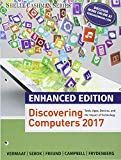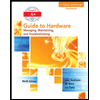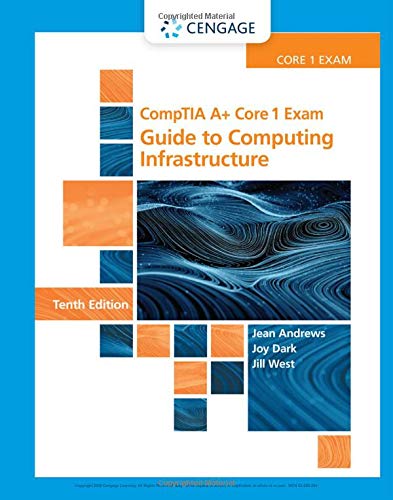
Bundle: Enhanced Discovering Computers ©2017, Loose-leaf Version + LMS Integrated MindTap Computing, 1 term (6 months) Printed Access Card
1st Edition
ISBN: 9781337351911
Author: Misty E. Vermaat, Susan L. Sebok, Steven M. Freund, Mark Frydenberg, Jennifer T. Campbell
Publisher: Cengage Learning
expand_more
expand_more
format_list_bulleted
Concept explainers
Expert Solution & Answer
Chapter 3, Problem 8CT
Explanation of Solution
System unit:
- System unit is the part of computer system that includes many devices and performs various operations to provide required results.
- It includes various components like mother board, Central Processing Unit (CPU), Random Access Memory (RAM) and many such.
- It is used for differentiating the computer system and its peripheral devices...
Expert Solution & Answer
Want to see the full answer?
Check out a sample textbook solution
Students have asked these similar questions
# Find the error# Why will the following code not print out a list of contact namesphoneBook = {'Doe, Jane' : '843-000-0000' ,'Doe, John' : '843-111-1111' ,'Smith, Adam' : '843-222-2222' ,'Jobs, Steve' : '999-333-3333' ,}for contact in phoneBook.values():print(contact)
# Find the error:# The following code creates an empty dictionary and attempts to add a record# Why will the following code not create a new dictionary entry as intended?phoneBook = {}phoneBook{'Jobs, Steve'} = '999-111-1111'
Select all the possible polar representations of the vector
that is obtained from rotating
where
by
Zrot
Ź
x =
3e²
T=
3п
8
Hint: Consider the negative angle that is equivalent to the positive angle of the rotated vector.
0
Chapter 3 Solutions
Bundle: Enhanced Discovering Computers ©2017, Loose-leaf Version + LMS Integrated MindTap Computing, 1 term (6 months) Printed Access Card
Ch. 3 - Prob. 1SGCh. 3 - Prob. 2SGCh. 3 - Prob. 3SGCh. 3 - Prob. 4SGCh. 3 - Prob. 5SGCh. 3 - Prob. 6SGCh. 3 - Prob. 7SGCh. 3 - Prob. 8SGCh. 3 - Prob. 9SGCh. 3 - Prob. 10SG
Ch. 3 - Prob. 11SGCh. 3 - Prob. 12SGCh. 3 - Prob. 13SGCh. 3 - Prob. 14SGCh. 3 - Prob. 15SGCh. 3 - Prob. 16SGCh. 3 - Prob. 17SGCh. 3 - Prob. 18SGCh. 3 - Prob. 19SGCh. 3 - Prob. 20SGCh. 3 - Prob. 21SGCh. 3 - Prob. 22SGCh. 3 - Prob. 23SGCh. 3 - Prob. 24SGCh. 3 - Prob. 25SGCh. 3 - Prob. 26SGCh. 3 - Prob. 27SGCh. 3 - Prob. 28SGCh. 3 - Prob. 29SGCh. 3 - Prob. 30SGCh. 3 - Prob. 31SGCh. 3 - Prob. 32SGCh. 3 - Prob. 33SGCh. 3 - Prob. 34SGCh. 3 - Prob. 35SGCh. 3 - Prob. 36SGCh. 3 - Prob. 37SGCh. 3 - Prob. 38SGCh. 3 - Prob. 39SGCh. 3 - Prob. 40SGCh. 3 - Prob. 41SGCh. 3 - Prob. 42SGCh. 3 - Prob. 43SGCh. 3 - Prob. 44SGCh. 3 - Prob. 45SGCh. 3 - Prob. 46SGCh. 3 - Prob. 47SGCh. 3 - Prob. 48SGCh. 3 - Prob. 49SGCh. 3 - Prob. 1TFCh. 3 - Prob. 2TFCh. 3 - Prob. 3TFCh. 3 - Prob. 4TFCh. 3 - Prob. 5TFCh. 3 - Prob. 6TFCh. 3 - Prob. 7TFCh. 3 - Prob. 8TFCh. 3 - Prob. 9TFCh. 3 - Prob. 10TFCh. 3 - Prob. 11TFCh. 3 - Prob. 12TFCh. 3 - Prob. 1MCCh. 3 - Prob. 2MCCh. 3 - Prob. 3MCCh. 3 - Prob. 4MCCh. 3 - Prob. 5MCCh. 3 - Prob. 6MCCh. 3 - Prob. 7MCCh. 3 - Prob. 8MCCh. 3 - Prob. 1MCh. 3 - Prob. 2MCh. 3 - Prob. 3MCh. 3 - Prob. 4MCh. 3 - Prob. 5MCh. 3 - Prob. 6MCh. 3 - Prob. 7MCh. 3 - Prob. 8MCh. 3 - Prob. 9MCh. 3 - Prob. 10MCh. 3 - Prob. 2CTCh. 3 - Prob. 3CTCh. 3 - Prob. 4CTCh. 3 - Prob. 5CTCh. 3 - Prob. 6CTCh. 3 - Prob. 7CTCh. 3 - Prob. 8CTCh. 3 - Prob. 9CTCh. 3 - Prob. 10CTCh. 3 - Prob. 11CTCh. 3 - Prob. 12CTCh. 3 - Prob. 13CTCh. 3 - Prob. 14CTCh. 3 - Prob. 15CTCh. 3 - Prob. 16CTCh. 3 - Prob. 17CTCh. 3 - Prob. 18CTCh. 3 - Prob. 19CTCh. 3 - Prob. 20CTCh. 3 - Prob. 21CTCh. 3 - Prob. 22CTCh. 3 - Prob. 23CTCh. 3 - Prob. 24CTCh. 3 - Prob. 25CTCh. 3 - Prob. 26CTCh. 3 - Prob. 27CTCh. 3 - Prob. 28CTCh. 3 - Prob. 29CTCh. 3 - Prob. 30CTCh. 3 - Prob. 1PSCh. 3 - Prob. 2PSCh. 3 - Prob. 3PSCh. 3 - Prob. 4PSCh. 3 - Prob. 5PSCh. 3 - Prob. 6PSCh. 3 - Prob. 7PSCh. 3 - Prob. 8PSCh. 3 - Prob. 9PSCh. 3 - Prob. 10PSCh. 3 - Prob. 11PSCh. 3 - Prob. 1.1ECh. 3 - Prob. 1.2ECh. 3 - Prob. 2.1ECh. 3 - Prob. 2.2ECh. 3 - Prob. 2.3ECh. 3 - Prob. 3.1ECh. 3 - Prob. 3.2ECh. 3 - Prob. 3.3ECh. 3 - Prob. 4.1ECh. 3 - Prob. 4.2ECh. 3 - Prob. 4.3ECh. 3 - Prob. 5.1ECh. 3 - Prob. 5.2ECh. 3 - Prob. 5.3ECh. 3 - Prob. 1IRCh. 3 - Prob. 2IRCh. 3 - Prob. 3IRCh. 3 - Prob. 4IRCh. 3 - Prob. 1CTQCh. 3 - Prob. 2CTQCh. 3 - Prob. 3CTQCh. 3 - Prob. 4CTQ
Knowledge Booster
Learn more about
Need a deep-dive on the concept behind this application? Look no further. Learn more about this topic, computer-science and related others by exploring similar questions and additional content below.Similar questions
- Character Analysis If you have downloaded the source code you will find a file named text.txt on the Chapter 08 folder. Write a program that reads the file's contents and determines the following: The number of uppercase letters in the file The number of lowercase letter in the file The number of digits in the file The number of whitespace characters in the filearrow_forwardWrite a program that reads the text file's contents and calculates and outputs the following in this order: • The number of words in the file • The number of lines in the file • The number of uppercase letters in the file • The number of lowercase letters in the file • The number of digits in the file • The number of letter H's in the file • The number of whitespace characters in the file NOTE: Your program should include at least one try-except error handling statement block. Your program should also validate any input that could cause your program to crash. I'm Henery The Eighth, I Am! Henery The Eighth, I Am, I am!I got married to the widow next door,She's been married seven times before.And ev'ryone was a Henery,She wouldn't have Willie or a Sam.I'm her eighth old man named Henery,Henery the Eighth, I Am!Second verse same as the first!I'm Henery The Eighth, I Am! Henery The Eighth, I Am, I am!I got married to the widow next door,She's been married seven times before.And…arrow_forwardFigure 4-40 Modern Database Management, 13th edition, question 4-53arrow_forward
- Which of the following needs improvement in the dashboard shown? A. Instructional clarity missing for the views B. Filter placed at the top of the dashboard C. Inconsistent use of colors to represent missed goals D. Dashboard title too largearrow_forwardIf we click Show dashboard title in this dashboard, what will the title be?arrow_forwardPlease draw the diagram where it is asked to be drawn. Don't just describe how to do it.arrow_forward
- C. Homework Assignment Task: Write a one-page CV using the provided template. Steps: 1. Use the CV guide to structure your CV. 2. Fill in each section with real information about yourself. 3. Format your CV neatly and use professional language. 4. Submit to the instructor before the next classarrow_forwardSimulate on a vertical time axis (with events labeled with the senders names A-D) the contention period of FOUR equally distanced Ethernet stations that all attempt to transmit at T=0 a minimally sized frame, in the style of the binary Exponential Backoff Algorithm. Assume that time is measured in slot times, and that exactly one slot time is needed to detect a collision (so that if two stations transmit at T=1 and collide, and one of them chooses a backoff time k=0, then that station will transmit again at T=2). Use as coin flip (source of randomness) an ID written in binary. use the bits in order from the least significant to the most significant. If for a given coin throw you need k bits, use the least significant ID bit extracted in the corresponding group of bits, as the least significant bit of the coin thrown. Start be writing the ID, which is 904012207 As example of the expected answer format, with the random sequence R: 100101010101001011001010 01 01011 10010 1010 1010 010…arrow_forwardBig State University The Big State University course catalog reads as follows: "To enroll in MIS 260, which is an advanced course, a student must complete two prerequisites: MIS 120 and MIS 222. A student who completes either one of these prerequisites and obtains the instructor's permission, however, will be allowed to take MIS 260." Tasks 1. Create a decision table that describes the Big State University course catalog regarding eligibility for MIS 260. Show all possible rules. 2. Simplify the table you just created. Describe the results. 3. Draw a simplified decision tree to represent the Big State University catalog. Describe the results. 4. Why might you use a decision tree rather than a decision table?arrow_forward
- What is the ALU result if the 4-bit ALU Control signal is 0100? What happens if the ALU Control signal is 0101?arrow_forward#include int main (void) { int i, *p, count } p = &count; = 10%; for (i = 5; i >= 0; i--) { count++; (*p) ++; } printf("count return 0; = %d, Have a wonderful day.\n", count); 1. [20 pts] What is the output of the program? Please explain why. 2. [15 pts] What is the gdb command to set a breakpoint in line 6 (p = &count;)? 3. [15 pts] Explain in your own words how the [break. need to use such command? ... if expr] command works. When might youarrow_forwardPlease run and debug the following program and answer the questions.arrow_forward
arrow_back_ios
SEE MORE QUESTIONS
arrow_forward_ios
Recommended textbooks for you
 Enhanced Discovering Computers 2017 (Shelly Cashm...Computer ScienceISBN:9781305657458Author:Misty E. Vermaat, Susan L. Sebok, Steven M. Freund, Mark Frydenberg, Jennifer T. CampbellPublisher:Cengage Learning
Enhanced Discovering Computers 2017 (Shelly Cashm...Computer ScienceISBN:9781305657458Author:Misty E. Vermaat, Susan L. Sebok, Steven M. Freund, Mark Frydenberg, Jennifer T. CampbellPublisher:Cengage Learning A+ Guide to Hardware (Standalone Book) (MindTap C...Computer ScienceISBN:9781305266452Author:Jean AndrewsPublisher:Cengage Learning
A+ Guide to Hardware (Standalone Book) (MindTap C...Computer ScienceISBN:9781305266452Author:Jean AndrewsPublisher:Cengage Learning Comptia A+ Core 1 Exam: Guide To Computing Infras...Computer ScienceISBN:9780357108376Author:Jean Andrews, Joy Dark, Jill WestPublisher:Cengage Learning
Comptia A+ Core 1 Exam: Guide To Computing Infras...Computer ScienceISBN:9780357108376Author:Jean Andrews, Joy Dark, Jill WestPublisher:Cengage Learning A+ Guide To It Technical SupportComputer ScienceISBN:9780357108291Author:ANDREWS, Jean.Publisher:Cengage,
A+ Guide To It Technical SupportComputer ScienceISBN:9780357108291Author:ANDREWS, Jean.Publisher:Cengage, Systems ArchitectureComputer ScienceISBN:9781305080195Author:Stephen D. BurdPublisher:Cengage Learning
Systems ArchitectureComputer ScienceISBN:9781305080195Author:Stephen D. BurdPublisher:Cengage Learning

Enhanced Discovering Computers 2017 (Shelly Cashm...
Computer Science
ISBN:9781305657458
Author:Misty E. Vermaat, Susan L. Sebok, Steven M. Freund, Mark Frydenberg, Jennifer T. Campbell
Publisher:Cengage Learning

A+ Guide to Hardware (Standalone Book) (MindTap C...
Computer Science
ISBN:9781305266452
Author:Jean Andrews
Publisher:Cengage Learning

Comptia A+ Core 1 Exam: Guide To Computing Infras...
Computer Science
ISBN:9780357108376
Author:Jean Andrews, Joy Dark, Jill West
Publisher:Cengage Learning

A+ Guide To It Technical Support
Computer Science
ISBN:9780357108291
Author:ANDREWS, Jean.
Publisher:Cengage,


Systems Architecture
Computer Science
ISBN:9781305080195
Author:Stephen D. Burd
Publisher:Cengage Learning